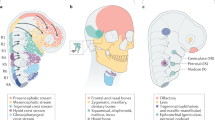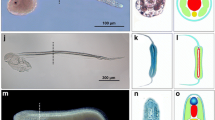Abstract
The recent advances in studies of the neural crest in vertebrates and the analysis of basal chordates using molecular and embryological approaches have demonstrated that at least part of the genetic programs and the cellular behavior were in place in nonvertebrate chordates before the neural crest evolved. Nevertheless, both the missing aspects and the close similarities found could explain why basal chordates lack a bona fide neural crest population, even though some migratory neurons and pigment cells have been recently identified in ascidians and amphioxus.
Access this chapter
Tax calculation will be finalised at checkout
Purchases are for personal use only
Preview
Unable to display preview. Download preview PDF.
Similar content being viewed by others
References
Gans C, Northcutt RG. Neural crest and the origin of vertebrates-A new head. Science 1983;220:268–274.
Hall BK. The neural crest as a fourth germ layer and vertebrates as quadroblastic not triploblastic. Evol Dev 2000;2:3–5.
Stone JR, Hall BK. Latent homologues for the neural crest as an evolutionary novelty. Evol Dev 2004;6:123–129.
Shimeld SM. Characterisation of amphioxus HNF-3 genes: Conserved Expression in the Notochord and Floor Plate. Dev Biol 1997;183:74–85.
Shimeld SM. The evolution of the hedgehog gene family in chordates: Insights from amphioxus hedgehog. Devel Genes Evol 1999;209:40–47.
Corbo J, Erives A, Di Gregorio A et al. Dorsoventral patterning of the vertebrate neural tube is conserved in a protochordate. Development 1997;124:2335–2344.
Holland LZ, Schubert M, Kozmik Z et al. AmphiPax3/7, an amphioxus paired box gene: Insights into chordate myogenesis, neurogenesis, and the possible evolutionary precursor of definitive vertebrate neural crest. Evol Dev 1999;1:153–165.
Wada H, Holland PW, Satoh N. Origin of patterning in neural tubes. Nature 1996;384:123.
Wada H, Holland PWH, Sato S et al. Neural tube is partially dorsalized by overexpression ofHrPax-37: The ascidian homologue of Pax-3 and Pax-7. Dev Biol 1997;187:240–252.
Conway SJ, Henderson DJ, Copp AJ. Pax3 is required for cardiac neural crest migration in the mouse: Evidence from the splotch (Sp2H) mutant. Development 1997;124:505–514.
Mansouri A, Stoykova A, Torres M et al. Dysgenesis of cephalic neural crest derivatives in Pax7-/-mutant mice. Development 1996;122:831–838.
Davidson D. The function and evolution of Msx genes: Pointers and paradoxes. Trends Genet 1995;11:405–411.
Sharman AC, Shimeld SM, Holland PWH. An amphioxus Msx gene expressed predominantly in the dorsal neural tube. Devel Genes Evol 1999;209:260–263.
Ma L, Swalla BJ, Zhou J et al. Expression of an Msx homeobox gene in ascidians: Insights into the archetypal chordate expression pattern. Dev Dyn 1996;205:308–218.
Aniello F, Locascio A, Villani MG et al. Identification and developmental expression of Ci-msxb: A novel homologue of Drosophila msh gene in Ciona intestinalis. Mech Dev 1999;88:123–126.
Brewster R, Lee J, Altaba AR. Gli/Zic factors pattern the neural plate by defining domains of cell differentiation. Nature 1998;393:579–583.
Aruga J. The role of Zic genes in neural development. Mol Cell Neurosci 2004;26:205–221.
Sato T, Sasai N, Sasai Y. Neural crest determination by coactivation of Pax3 and Zic1 genes in Xenopus ectoderm. Development 2005;132:2355–2363.
Gostling NJ, Shimeld SM. Protochordate Zic genes define primitive somite compartments and highlight molecular changes underlying neural crest evolution. Evol Dev 2003;5:136–144.
Marchant L, Linker C, Ruiz P et al. The inductive properties of mesoderm suggest that the neural crest cells are specified by a BMP gradient. Dev Biol 1998;198:319–329.
Nguyen VH, Schmid B, Trout J et al. Ventral and lateral regions of the zebrafish gastrula, including the neural crest progenitors, are stablished by a bmp2b/swirl pathway of genes. Dev Biol 1998;1999:93–110.
Panopoulou GD, Clark MD, Holland LZ et al. AmphiBMP2/4, an amphioxus bone morphogenetic protein closely related to Drosophila decapentaplegic and vertebrate BMP2 and BMP4: Insights into evolution of dorsoventral axis specification. Dev Dyn 1998;213:130–139.
Schneider RA, Helms JA. The cellular and molecular origins of beak morphology. Science 2003;299:565–568.
Wu P, Jiang T-X, Suksaweang S et al. Molecular shaping of the beak. Science 2004;305:1465–1466.
Abzhanov A, Protas M, Grant BR et al. Bmp4 and morphological variation of beaks in Darwin’s finches. Science 2004;305:1462–1465.
Holland N, Panganiban G, Henyey E et al. Sequence and developmental expression of AmphiDll, an amphioxus Distal-less gene transcribed in the ectoderm, epidermis and nervous system: Insights into evolution of craniate forebrain and neural crest. Development 1996;122:2911–2920.
Weston JA, Yoshida H, Robinson V et al. Neural crest and the origin of ectomesenchyme: Neural fold heterogeneity suggests an alternative hypothesis. Dev Dyn 2004;229:118–130.
Dolle P, Price M, Duboule D. Expression of the murine Dlx-1 homeobox gene during facial, ocular and limb development. Differentiation 1992;49:93–99.
Jeffery WR, Strickler AG, Yamamoto Y. Migratory neural crest-like cells form body pigmentation in a urochordate embryo. Nature 2004;431:696–699.
Benito-Gutierrez E, Nake C, Llovera M et al. The single AmphiTrk receptor highlights increased complexity of neurotrophin signalling in vertebrates and suggests an early role in developing sensory neuroepidermal cells. Development 2005;132:2191–2202.
Martin-Zanca D, Barbacid M, Parada LF. Expression of the trk proto-oncogene is restricted to the sensory cranial and spinal ganglia of neural crest origin in mouse development. Genes Dev 1990;4:683–694.
Nieto MA. The snail superfamily of zinc-finger transcription factors. Nat Rev Mol Cell Biol 2002;3:155–166.
Langeland JA, Tomsa Jr JM, WRJ et al. An amphioxus snail gene: Expression in paraxial mesoderm and neural plate suggests a conserved role in patterning the chordate embryo. Devel Genes Evol 1998;208:569–577.
Wakamatsu Y, Endo Y, Osumi N et al. Multiple roles of Sox2, an HMG-box transcription factor in avian neural crest development. Dev Dyn 2004;229:74–67.
Holland LZ, Schubert M, Holland ND et al. Evolutionary conservation of the presumptive neural plate markers amphisox 1/2/3 and amphineurogenin in the invertebrate chordate amphioxus. Dev Biol 2000;226:18–33.
Meulemans D, Bronner-Fraser M. Gene-regulatory interactions in neural crest evolution and development. Dev Cell 2004;7:291–299.
Kee Y, Bronner-Fraser M. To proliferate or to die: Role of Id3 in cell cycle progression and survival of neural crest progenitors. Genes Dev 2005;19:744–755.
Light W, Vernon AE, Lasorella A et al. Xenopus Id3 is required downstream of Myc for the formation of multipotent neural crest progenitor cells. Development 2005;132:1831–1841.
Meulemans D, McCauley D, Bronner-Fraser M. Id expression in amphioxus and lamprey highlights the role of gene cooption during neural crest evolution. Dev Biol 2003;264:430–442.
Graham A, Papalopulu N, Krumlauf R. The murine and Drosophila homeobox gene complexes have common features of organization and expression. Cell 1989;57:367–378.
Duboule D, Dolle P. The structural and functional organization of the murine HOX gene family resembles that of Drosophila homeotic genes. EMBO J 1989;8:1497–1505.
Hunt P, Wilkinson D, Krumlauf R. Patterning the vertebrate head: Murine Hox 2 genes mark distinct subpopulations of premigratory and migrating cranial neural crest. Development 1991;112:43–50.
Hunt P, Gulisano M, Cook M et al. A distinct Hox code for the branchial region of the vertebrate head. Nature 1991;353:861–864.
Wada H, Garcia-Fernandez J, Holland PWH. Colinear and segmental expression of amphioxus Hox genes. Dev Biol 1999;213:131–141.
Manzanares M, Wada H, Itasaki N et al. Conservation and elaboration of Hox gene regulation during evolution of the vertebrate head. Nature 2000;408:854–857.
Pasqualetti M, Ori M, Nardi I et al. Ectopic Hox2a induction after neural crest migration results in homeosis of jaw elements in Xenopus. Development 2000;127:5367–5378.
Grammatopoulos GA, Bell E, Toole L et al. Homeotic transformation of branchial arch identity after Hox2a overexpression. Development 2000;127:5355–5365.
Gendron-Maguire M, Mallo M, Zhang M et al. Hoxa-2 mutant mice exhibit homeotic transformation of skeletal elements derived from cranial neural crest. Cell 1993;75:1317–1331.
Rijli FM, Mark M, Lakkaraju S et al. A homeotic transformation is generated in the rostral branchial region of the head by disruption of Hoxa-2, which acts as a selector gene. Cell 1993;75:1333–1349.
Conn MJ. Lamprey Hox genes and the origin of jaws. Nature 2002;416:386–387.
Takio Y, Pasqualetti M, Kuraku S et al. Lamprey Hox genes and the evolution of jaws. Nature 2004;429.
Ohno S. Evolution by gene duplication. New York: Spinger-Verlag, 1970.
Ohno S. Gene duplication and the uniqueness of vertebrate genomes circa 1970-1999. Semin Cell Dev Biol 1999;10:517–522.
Holland PWH, García-Fernández J, Williams NA et al. Gene duplications and the origins of vertebrate development. Development 1994;(Suppl):125–133.
Leveugle M, Prat K, Popovici C et al. Phylogenetic analysis of ciona intestinalis gene superfamilies supports the hypothesis of successive gene expansions. J Mol Evol 2004;58:168–181.
Seo H-C, Edvardsen RB, Maeland AD et al. Hox cluster disintegration with persistent anteroposterior order of expression in Oikopleura dioica. Nature 2004;431:67–71.
Ikuta T, Yoshida N, Satoh N et al. Ciona intestinalis Hox gene cluster: Its dispersed structure and residual colinear expression in development. Proc Natl Acad Sci USA 2004;101:15118–15123.
Garcia-Fernandez J, Holland PW. Archetypal organization of the amphioxus Hox gene cluster. Nature 1994;370:563–566.
Garcia-Fernandez J. Hox, ParaHox, ProtoHox: Facts and guesses. Heredity 2005;94:145–152.
Amores A, Force A, Yan YL et al. Zebrafish hox clusters and vertebrate genome evolution. Science 1998;282:1711–1714.
Postlethwait JH, Yan LY, Gates MA et al. Vertebrate genome evolution and the zebrafish gene map. Nat Genet 1998;18:345–349.
Force A, Lynch M, Pickett FB et al. Preservation of duplicate genes by complementary, degenerative mutations. Genetics 1999;151:1531–1545.
Thisse C, Thisse B, Schilling TF et al. Structure of the zebrafish snail1 gene and its expression in wild-type, spadetail and no tail embryos. Development 1993;119:1203–1215.
Thisse C, Thisse B, Postlethwait JH. Expression of snail2, a second member of the zebrafish snail family, in cephalic mesoderm and presumptive neural crest of wild-type and spadetail mutant embryos. Dev Biol 1995;172:86–99.
Yan Y-L, Willoughby J, Liu D et al. A pair of Sox: Distinct and overlapping functions of zebrafish sox9 coorthologs in craniofacial and pectoral fin development. Development 2005;132:1069–1083.
Cheung M, Chaboissier M-C, Mynett A et al. The transcriptional control of trunk neural crest induction, survival, and delamination. Dev Cell 2005;8:179–192.
Kaestner KH, Knochel W, Martinez DE. Unified nomenclature for the winged helix/forkhead transcription factors. Genes Dev 2000;14:142–146.
Lehmann OJ, Sowden JC, Carlsson P et al. Fox’s in development and disease. Trends Genet 2003;19:339–344.
Kos R, Reedy MV, Johnson RL et al. The winged-helix transcription factor FoxD3 is important for establishing the neural crest lineage and repressing melanogenesis in avian embryos. Development 2001;128:1467–1479.
Sasai N, Mizuseki K, Sasai Y. Requirement of FoxD3-class signaling for neural crest determination in Xenopus. Development 2001;128:2525–2536.
Dottori M, Gross MK, Labosky P et al. The winged-helix transcription factor Foxd3 suppresses interneuron differentiation and promotes neural crest cell fate. Development 2001;128:4127–4138.
Dutton KA, Pauliny A, Lopes SS et al. Zebrafish colourless encodes sox10 and specifies nonectomesenchymal neural crest fates. Development 2001;128:4113–4125.
Imai KS, Satoh N, Satou Y. An essential role of a FoxD gene in notochord induction in Ciona embryos. Development 2002;129:3441–3453.
Yu JK, Holland ND, Holland LZ. An amphioxus winged helix/forkhead gene, AmphiFoxD: Insights into vertebrate neural crest evolution. Dev Dyn 2002;225:289–297.
Knight RD, Nair S, Nelson SS et al. lockjaw encodes a zebrafish tfap2a required for early neural crest development. Development 2003;130:5755–5768.
Barrallo-Gimeno A, Holzschuh J, Driever W et al. Neural crest survival and differentiation in zebrafish depends on mont blanc/tfap2a gene function. Development 2004;131:1463–1477.
Meulemans D, Bronner-Fraser M. Amphioxus and lamprey AP-2 genes: Implications for neural crest evolution and migration patterns. Development 2002;129:4953–4962.
Maconochie M, Krishnamurthy R, Nonchev S et al. Regulation of Hoxa2 in cranial neural crest cells involves members of the AP-2 family. Development 1999;126:1483–1494.
Manzanares M, Nieto M. A celebration of the new head and a evaluation of the new mouth. Neuron 2003;37:895–898.
Yu J-K, Holland ND, Holland LZ. Tissue-specific expression of FoxD reporter constructs in amphioxus embryos. Dev Biol 2004;274:452–461.
Author information
Authors and Affiliations
Corresponding author
Editor information
Editors and Affiliations
Rights and permissions
Copyright information
© 2006 Landes Bioscience and Springer Science+Business Media
About this chapter
Cite this chapter
Barrallo-Gimeno, A., Nieto, M.A. (2006). Evolution of the Neural Crest. In: Saint-Jeannet, JP. (eds) Neural Crest Induction and Differentiation. Advances in Experimental Medicine and Biology, vol 589. Springer, Boston, MA. https://doi.org/10.1007/978-0-387-46954-6_15
Download citation
DOI: https://doi.org/10.1007/978-0-387-46954-6_15
Publisher Name: Springer, Boston, MA
Print ISBN: 978-0-387-35136-0
Online ISBN: 978-0-387-46954-6
eBook Packages: Biomedical and Life SciencesBiomedical and Life Sciences (R0)




